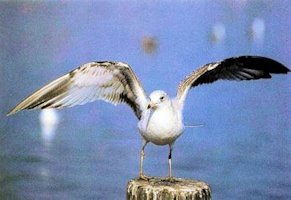
|
Slow Flapping Flight of Birds Small birds -- the size of an American Crow and downwards -- can glide but cannot soar in updrafts on land or gusts over the sea. These birds must generate their own energy for flight that larger, soaring birds receive from air currents. This energy as achieved by beating the wings, which are driven by the strong pectoral muscles in what is called Flapping Flight. A young Ring-billed Gull spreads it wings in preparation for takeoff.Click for Flapping Flight Diagram |
|
Flapping flight consists of two distinct movements: the power stroke and the back stroke. In the power stroke, the wings move forward and down; the back stroke returns the wings to the position from which the next power stroke will commence. During a glide the inner wings (the secondary feathers) and the "hand " regions (the primary feathers) are spread to produce a continuous airfoil. During a flap, however, the two parts of the wing carry out different functions. The inner wings give lift, while the "hands" pull the body forward. During the power stroke the primary feathers are linked together to produce a near-perfect airfoil, giving the maximum thrust and minimum drag. In smaller birds the primary feathers are separated like the slots in a venetian blind on the back stroke, allowing air to pass through and considerably reducing drag. Larger birds, like gulls and the small but long-winged birds of the swallow family, either flex or partially close their wings on the back stroke. With the help of slow-motion photography, scientists have been able to see quite clearly just how this system operates. |
|